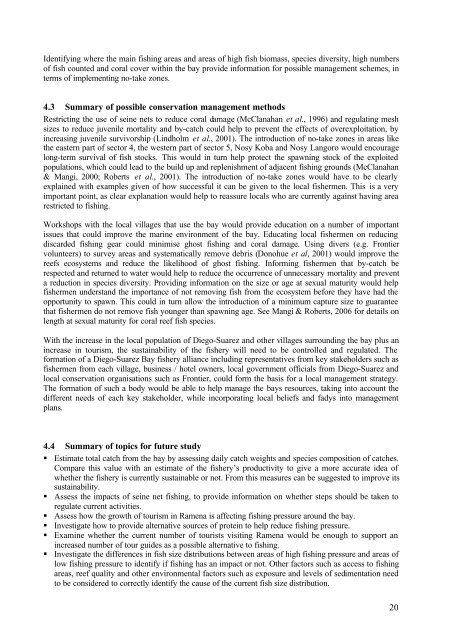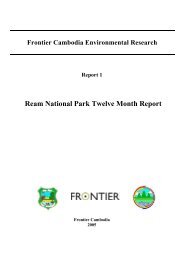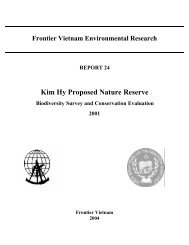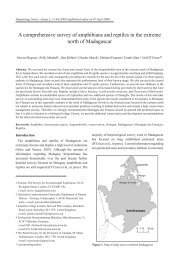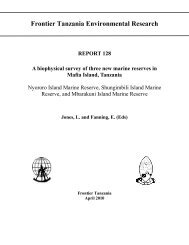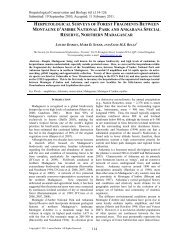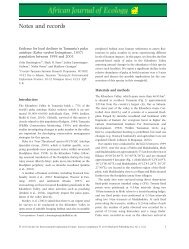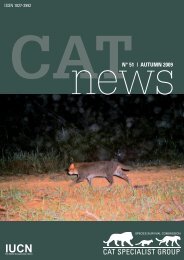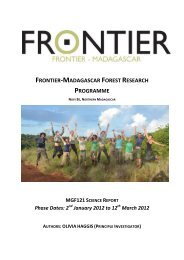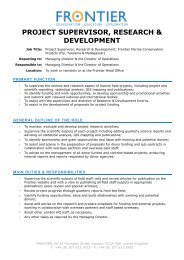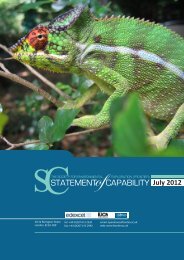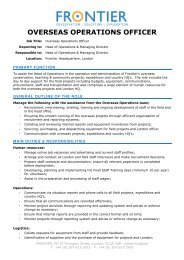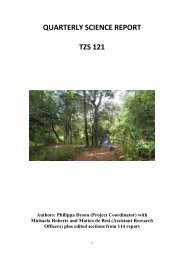An assessment of local fisheries in Diego-Suarez Bay, Madagascar
An assessment of local fisheries in Diego-Suarez Bay, Madagascar
An assessment of local fisheries in Diego-Suarez Bay, Madagascar
You also want an ePaper? Increase the reach of your titles
YUMPU automatically turns print PDFs into web optimized ePapers that Google loves.
Identify<strong>in</strong>g where the ma<strong>in</strong> fish<strong>in</strong>g areas and areas <strong>of</strong> high fish biomass, species diversity, high numbers<br />
<strong>of</strong> fish counted and coral cover with<strong>in</strong> the bay provide <strong>in</strong>formation for possible management schemes, <strong>in</strong><br />
terms <strong>of</strong> implement<strong>in</strong>g no-take zones.<br />
4.3 Summary <strong>of</strong> possible conservation management methods<br />
Restrict<strong>in</strong>g the use <strong>of</strong> se<strong>in</strong>e nets to reduce coral damage (McClanahan et al., 1996) and regulat<strong>in</strong>g mesh<br />
sizes to reduce juvenile mortality and by-catch could help to prevent the effects <strong>of</strong> overexploitation, by<br />
<strong>in</strong>creas<strong>in</strong>g juvenile survivorship (L<strong>in</strong>dholm et al., 2001). The <strong>in</strong>troduction <strong>of</strong> no-take zones <strong>in</strong> areas like<br />
the eastern part <strong>of</strong> sector 4, the western part <strong>of</strong> sector 5, Nosy Koba and Nosy Langoro would encourage<br />
long-term survival <strong>of</strong> fish stocks. This would <strong>in</strong> turn help protect the spawn<strong>in</strong>g stock <strong>of</strong> the exploited<br />
populations, which could lead to the build up and replenishment <strong>of</strong> adjacent fish<strong>in</strong>g grounds (McClanahan<br />
& Mangi, 2000; Roberts et al., 2001). The <strong>in</strong>troduction <strong>of</strong> no-take zones would have to be clearly<br />
expla<strong>in</strong>ed with examples given <strong>of</strong> how successful it can be given to the <strong>local</strong> fishermen. This is a very<br />
important po<strong>in</strong>t, as clear explanation would help to reassure <strong>local</strong>s who are currently aga<strong>in</strong>st hav<strong>in</strong>g area<br />
restricted to fish<strong>in</strong>g.<br />
Workshops with the <strong>local</strong> villages that use the bay would provide education on a number <strong>of</strong> important<br />
issues that could improve the mar<strong>in</strong>e environment <strong>of</strong> the bay. Educat<strong>in</strong>g <strong>local</strong> fishermen on reduc<strong>in</strong>g<br />
discarded fish<strong>in</strong>g gear could m<strong>in</strong>imise ghost fish<strong>in</strong>g and coral damage. Us<strong>in</strong>g divers (e.g. Frontier<br />
volunteers) to survey areas and systematically remove debris (Donohue et al, 2001) would improve the<br />
reefs ecosystems and reduce the likelihood <strong>of</strong> ghost fish<strong>in</strong>g. Inform<strong>in</strong>g fishermen that by-catch be<br />
respected and returned to water would help to reduce the occurrence <strong>of</strong> unnecessary mortality and prevent<br />
a reduction <strong>in</strong> species diversity. Provid<strong>in</strong>g <strong>in</strong>formation on the size or age at sexual maturity would help<br />
fishermen understand the importance <strong>of</strong> not remov<strong>in</strong>g fish from the ecosystem before they have had the<br />
opportunity to spawn. This could <strong>in</strong> turn allow the <strong>in</strong>troduction <strong>of</strong> a m<strong>in</strong>imum capture size to guarantee<br />
that fishermen do not remove fish younger than spawn<strong>in</strong>g age. See Mangi & Roberts, 2006 for details on<br />
length at sexual maturity for coral reef fish species.<br />
With the <strong>in</strong>crease <strong>in</strong> the <strong>local</strong> population <strong>of</strong> <strong>Diego</strong>-<strong>Suarez</strong> and other villages surround<strong>in</strong>g the bay plus an<br />
<strong>in</strong>crease <strong>in</strong> tourism, the susta<strong>in</strong>ability <strong>of</strong> the fishery will need to be controlled and regulated. The<br />
formation <strong>of</strong> a <strong>Diego</strong>-<strong>Suarez</strong> <strong>Bay</strong> fishery alliance <strong>in</strong>clud<strong>in</strong>g representatives from key stakeholders such as<br />
fishermen from each village, bus<strong>in</strong>ess / hotel owners, <strong>local</strong> government <strong>of</strong>ficials from <strong>Diego</strong>-<strong>Suarez</strong> and<br />
<strong>local</strong> conservation organisations such as Frontier, could form the basis for a <strong>local</strong> management strategy.<br />
The formation <strong>of</strong> such a body would be able to help manage the bays resources, tak<strong>in</strong>g <strong>in</strong>to account the<br />
different needs <strong>of</strong> each key stakeholder, while <strong>in</strong>corporat<strong>in</strong>g <strong>local</strong> beliefs and fadys <strong>in</strong>to management<br />
plans.<br />
4.4 Summary <strong>of</strong> topics for future study<br />
Estimate total catch from the bay by assess<strong>in</strong>g daily catch weights and species composition <strong>of</strong> catches.<br />
Compare this value with an estimate <strong>of</strong> the fishery’s productivity to give a more accurate idea <strong>of</strong><br />
whether the fishery is currently susta<strong>in</strong>able or not. From this measures can be suggested to improve its<br />
susta<strong>in</strong>ability.<br />
Assess the impacts <strong>of</strong> se<strong>in</strong>e net fish<strong>in</strong>g, to provide <strong>in</strong>formation on whether steps should be taken to<br />
regulate current activities.<br />
Assess how the growth <strong>of</strong> tourism <strong>in</strong> Ramena is affect<strong>in</strong>g fish<strong>in</strong>g pressure around the bay.<br />
Investigate how to provide alternative sources <strong>of</strong> prote<strong>in</strong> to help reduce fish<strong>in</strong>g pressure.<br />
Exam<strong>in</strong>e whether the current number <strong>of</strong> tourists visit<strong>in</strong>g Ramena would be enough to support an<br />
<strong>in</strong>creased number <strong>of</strong> tour guides as a possible alternative to fish<strong>in</strong>g.<br />
Investigate the differences <strong>in</strong> fish size distributions between areas <strong>of</strong> high fish<strong>in</strong>g pressure and areas <strong>of</strong><br />
low fish<strong>in</strong>g pressure to identify if fish<strong>in</strong>g has an impact or not. Other factors such as access to fish<strong>in</strong>g<br />
areas, reef quality and other environmental factors such as exposure and levels <strong>of</strong> sedimentation need<br />
to be considered to correctly identify the cause <strong>of</strong> the current fish size distribution.<br />
20


